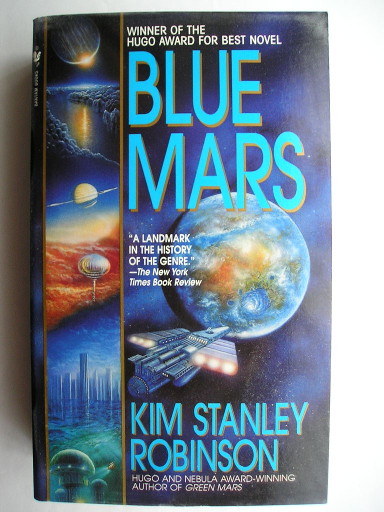
The novel “Blue Mars” by Kim Stanley Robinson was published for the first time in 1996. It won the Hugo and Locus Awards. It’s the third novel in the Mars trilogy and follows “Green Mars“.
Over a century after the arrival of the first human expedition to Mars, terraforming operations caused enormous changes to what used to be the red planet. Water is in its liquid state on the surface forming seas and rivers. On Earth, however, water has become a major issue following climate changes.
The relationship between Earth and Mars remains tense and the treaty between the two planets marks a difficult peace. Immigration from the Earth keeps on growing and represents another reason for conflict among the Martian factions. There are still those who oppose terraforming and consider the Earthlings as invaders that must be stopped.
“Blue Mars” is the direct continuation of “Green Mars”, concluding some subplots of the second novel of the Mars trilogy and continuing the development of various themes. In particular, the theme of Mars terraforming remains crucial even though Kim Stanley Robinson keeps on developing many others.
Mars and Earth find an agreement that is the result of a compromise and satisfies only partially the two planets’ inhabitants. The Earth is suffering more than ever the overpopulation problem due to the effects of climate change but even sending millions of people to Mars is a facade operation and not a solution. On the other hand, for many Martians that immigration is a threat to a planet in a delicate phase of its transformation.
This situation allows Kim Stanley Robinson to keep on developing the political and social issues that have been important since the first novel. In “Blue Mars” the perspective is expanded in various ways, beginning with the arrival of a Martian delegation on Earth to sign a treaty.
The reactions to Earth are very different, even opposite. Michel is one of the first 100 so for him the journey is a return to his birth planet. Nirgal is a native of Mars so for him it’s a journey on a planet that is alien to him. Michel literally finds his family so even after a century he can feel again at home. On the contrary, the Earth’s environment literally makes Nirgal sick.
The natives of Mars are comfortable in the environment in which they were born and grew up, but the terraforming of what used to be the red planet continues so it’s a changing environment. The conditions on the surface allow water to remain liquid so on Mars seas and rivers form, like when it was young.
There’s a faction of Martians who keeps on not accepting the situation because they keep on wanting to maintain Mars’ environment in its original state. This is where my perplexities about “Blue Mars” begin because these contrasts become repetitive and after more than a century they seem increasingly absurd because at that point the planet has changed and even if the terraforming failed Mars wouldn’t go back to exactly what it was before human intervention.
My doubts continue in general on the structure of the novel. The first part is fine because it ends the trilogy’s main subplots of but my impression is that Kim Stanley Robinson noticed that the result was too short a novel and had to look for new ways to make it longer.
An interesting development of “Blue Mars” is a further step forward in colonization, which begins to extend to other places in the solar system. This subplot would deserve at least a separete novel if not a new series, instead it’s a sort of novella within a novel that eventually became the longest in the trilogy.
To make the novel longer, Kim Stanley Robinson also includes many discussions about Hiroko’s sightings. Hiroko disappeared at the end of “Green Mars” and is presumably dead but continually somebody claims to have seen her in various places on Mars and even on Earth. Hiroko becomes a bit like the Elvis equivalent but honestly all this space for discussions about her sightings seems useless in a novel that is very long and complex.
Paradoxically, in the end it seems that Kim Stanley Robinson realized that he made “Blue Mars” too long and the ending is really hurried. It’s a shame because the final events are supposed to lead to significant political and social changes on Mars with consequences also in the rest of the solar system.
I would have preferred Kim Stanley Robinson to eliminate everything about Hiroko’s sightings and to create a sort of spin-off for the story of Zo, connected to the colonization of other places in the solar system, into a novella and make the final part of “Blue Mars” longer. In the end, this novel is the most chaotic of the trilogy with a very variable pace.

Don’t get me wrong, “Blue Mars” also contains the merits that brought so much praise to the trilogy, so much that this novel won the Hugo and Locus Awards as well. The problem is that this time the flaws are more pronounced. If you have already read the two previous novels, you still have to read the third one to complete a trilogy that overall is of a high level. If you liked it, you can also read “The Martians”, an anthology of stories connected to the trilogy.

